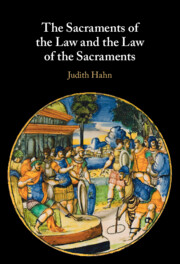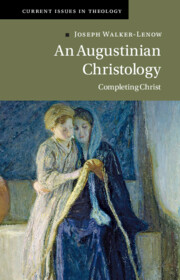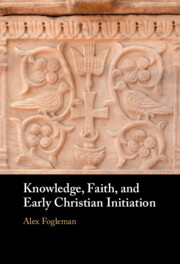77 results
Conclusion
-
- Book:
- Conversion and the Contest of Creeds in Early Medieval Christianity
- Print publication:
- 13 June 2024, pp 284-294
-
- Chapter
- Export citation
II.40 - A Woman Is Tried for Heresy at Norwich: a Court Record
- from Fifteenth Century
-
- Book:
- The Cambridge Anthology of British Medieval Latin
- Published online:
- 11 January 2024
- Print publication:
- 01 February 2024, pp 352-356
-
- Chapter
- Export citation
II.50 - Safeguarding, Accidents and Death
- from Fifteenth Century
-
- Book:
- The Cambridge Anthology of British Medieval Latin
- Published online:
- 11 January 2024
- Print publication:
- 01 February 2024, pp 491-504
-
- Chapter
- Export citation
Chapter 6 - The Ordo Romanus of the Baptismal Scrutinies
- from Part II - The Arrangement of Rites
-
- Book:
- Roman Liturgy and Frankish Creativity
- Published online:
- 04 January 2024
- Print publication:
- 18 January 2024, pp 140-177
-
- Chapter
- Export citation
8 - The Nature of Sin
-
- Book:
- Augustine on the Nature of Virtue and Sin
- Published online:
- 10 January 2024
- Print publication:
- 23 November 2023, pp 269-308
-
- Chapter
- Export citation
10 - A Resurrected Body
- from Part III - The Body of Christ
-
- Book:
- An Augustinian Christology
- Published online:
- 02 November 2023
- Print publication:
- 16 November 2023, pp 342-377
-
- Chapter
- Export citation

The Sacraments of the Law and the Law of the Sacraments
-
- Published online:
- 09 November 2023
- Print publication:
- 23 November 2023

An Augustinian Christology
- Completing Christ
-
- Published online:
- 02 November 2023
- Print publication:
- 16 November 2023
2 - The Beginnings of a Christian Doctrine of the Spiritual Senses before Origen
-
-
- Book:
- The Intellectual World of Late Antique Christianity
- Published online:
- 05 October 2023
- Print publication:
- 26 October 2023, pp 21-46
-
- Chapter
- Export citation
Chapter 1 - Neither Jewish nor Pagan?
-
- Book:
- The Early Christians
- Published online:
- 05 October 2023
- Print publication:
- 26 October 2023, pp 25-115
-
- Chapter
- Export citation
3 - Simplicity and Power
-
- Book:
- Knowledge, Faith, and Early Christian Initiation
- Published online:
- 11 October 2023
- Print publication:
- 19 October 2023, pp 69-92
-
- Chapter
- Export citation
Chapter 14 - The Sacrament and the Altar
- from Holy Ordinances
-
- Book:
- On Laudianism
- Published online:
- 05 October 2023
- Print publication:
- 19 October 2023, pp 179-188
-
- Chapter
- Export citation
5 - The Harbor on High
-
- Book:
- Knowledge, Faith, and Early Christian Initiation
- Published online:
- 11 October 2023
- Print publication:
- 19 October 2023, pp 114-133
-
- Chapter
- Export citation

Knowledge, Faith, and Early Christian Initiation
-
- Published online:
- 11 October 2023
- Print publication:
- 19 October 2023
The Woman between Us: Sarah Nakimu Nalwanga and the Founding of Uganda’s Anglican Tradition
-
- Journal:
- Journal of Anglican Studies , First View
- Published online by Cambridge University Press:
- 22 September 2023, pp. 1-14
-
- Article
-
- You have access
- Open access
- HTML
- Export citation
The Open Debate on Open Communion in The Episcopal Church
-
- Journal:
- Journal of Anglican Studies / Volume 21 / Issue 2 / November 2023
- Published online by Cambridge University Press:
- 23 August 2023, pp. 235-245
-
- Article
- Export citation
“In the Name of the (God)Father”: Baptismal Naming in Early Colonial Guatemala
-
- Journal:
- The Americas / Volume 80 / Issue 2 / April 2023
- Published online by Cambridge University Press:
- 20 April 2023, pp. 183-219
- Print publication:
- April 2023
-
- Article
-
- You have access
- Open access
- HTML
- Export citation
7 - The Contents of the Spiritual Resurrection
- from III - The Resurrectionof the Human Spirit
-
- Book:
- Augustine's Theology of the Resurrection
- Published online:
- 21 April 2023
- Print publication:
- 30 March 2023, pp 121-137
-
- Chapter
- Export citation
5 - Original Sin and Justification
-
-
- Book:
- The Cambridge Companion to the Council of Trent
- Published online:
- 02 October 2023
- Print publication:
- 16 March 2023, pp 97-121
-
- Chapter
- Export citation
‘The Whole Nature of the Child’: Children and Youth at the Lambeth Conferences
-
- Journal:
- Journal of Anglican Studies / Volume 22 / Issue 1 / May 2024
- Published online by Cambridge University Press:
- 23 February 2023, pp. 111-135
-
- Article
- Export citation



